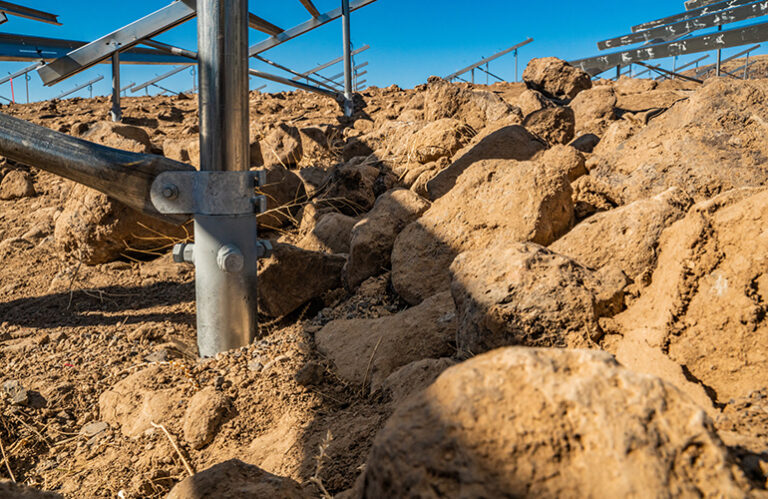German inventor Klaus Krinner, who created a Christmas tree stand bearing his last name in 1987, was given the humbling task of setting up a pole in his yard to hang laundry. Not only did the laundry pole remain upright, but another great invention was created: the first Krinner ground screw.

Credit: Terrasmart
Today, ground screws are a common foundational choice for construction projects. They are used for signage, lighting, utilities and buildings of two stories or less. The ground-mounted mount has also gained popularity in the large-scale U.S. solar market, as PV projects take hold in areas with hillier landscapes and challenging ground conditions.
“It’s perfect for us because we shine when the ground is difficult,” says Enmanuel Rumbos, Chief Strategic Officer at Krinner Schraubfundamente GmbH.
The modern grounding screw did not originate from solar construction, but according to Rumbos it was validated by it. Krinner – not the company that produces ground screws, but its founder – applied for worldwide patents on the foundation after it was deployed in one of the first substantial solar energy projects in Germany.
Those patents eventually expired and the market grew dramatically, with manufacturers producing their own ground screws, many of which came from China. A few others, including Krinner, have begun producing ground screws in the United States to reap the benefits of domestic production subsidies from the Inflation Reduction Act.
It’s making its way into American solar construction
I-, C-, or H-beams still dominate solar pole choices due to their cheaper production compared to ground screws. However, depending on the project location, ground screws have an edge that may make more economic sense than beam piles.
When an I-beam is deployed under challenging site conditions, the chance of refusals is greater. The beam itself could be much longer compared to ground screws, which can be embedded at a shallower depth and respond better to frost impact.
APA solar racks of Ridgeville Corners, Ohio, began producing spiral piles, a driven foundation with two to three arched wires designed to withstand frost. The company started selling ground screws seven years ago and recently started manufacturing them domestically. APA found that both ground screws and coils use largely the same equipment for installation and undergo the same push, pull, and lateral load tests for deployment.
The main difference is that ground screws have a much larger thread section than spirals. Ground screws, which resemble the common wood screw, began to gain traction as the New England market opened up to large-scale solar projects. The northeastern floor is littered with glaciers, cobbles, boulders and rocks – ideal conditions for ground screws.
“There is simply no other type of foundation that can do something like a ground screw,” says Josh Von Deylen, CEO of APA Solar Racking.

A ground screw floating in rocky ground. Terrace mart
Terrace marta turnkey solar rack manufacturer and installation service based in Fort Myers, Florida, was an early adopter of ground screws for PV projects in the United States and a long-time Krinner customer. The company has tested and cataloged every installed project, resulting in a data log of 12,000 ground screw tests and a standardized method for installing ground screw projects.
A geotechnical investigation is carried out at a project location prior to installation. Installers perform a tensile test in the ground to determine the correct depth for embedding ground screws. Ground screws are installed by drilling pilot holes and are later drilled into place with a pile driver or other specialized equipment. In order to work optimally at a project location, the thread of the ground screw must be driven below the frost line, otherwise there is a risk of frost.
Having smaller threads means ground screws can work around underground obstacles. If there are boulders or bedrock at a project site, a pilot hole is drilled into the bedrock, filled with aggregate and the ground screw is driven into the hole and secured.
“Applying a ground screw to those locations is a much more predictable feat,” said Chase Anderson, director of engineering at Terrasmart. “The ground screw is really the product that you put in locations that traditionally might not have been suitable for solar energy.”
Take large-scale projects to new heights
A driving trend among solar trackers is that these moving solar racks can work on uneven landscapes. Solar trackers have taken new forms with hinged poles that will follow the contours of project sites, but hilly land often has obstacles beneath the surface.
“In the past, a tracker project was located on a nice, large, flat field. There’s a reason they’re flat. Its geology and soils are usually quite good,” said Von Deylen. “The industry is growing so much that solar energy cannot only work on flat locations. Better locations may include high topography, where people do not farm, or where rocks and cobblestones are present.”
So the fundamentals of solar trackers had to change to adapt to these project locations, creating a new demand for ground screws. In 2021, APA Solar Racking introduced its A-Frame Tracker Foundation, an A-shaped mounting structure that uses ground screws and works with third-party single-axis solar trackers. That same year, Terrasmart debuted TerraTrak, its foray into solar tracking, which uses an A-frame-style foundation supported by ground screws.
Nextracker acquired ground mounting manufacturer Ojjo in 2024 and is using its Earth Truss foundation for tracker projects. Earth Truss uses two threaded posts, such as ground screws, that are driven into the ground at a 45° angle.
Ground screws may not be the cheap choice for every solar project, but they are a better option for making an array work in challenging locations with uneven surfaces and obstacles underneath. A ground screw can hold a laundry pole in place in a garden just as well as a solar project on a mountainside – all thanks to Klaus Krinner.


